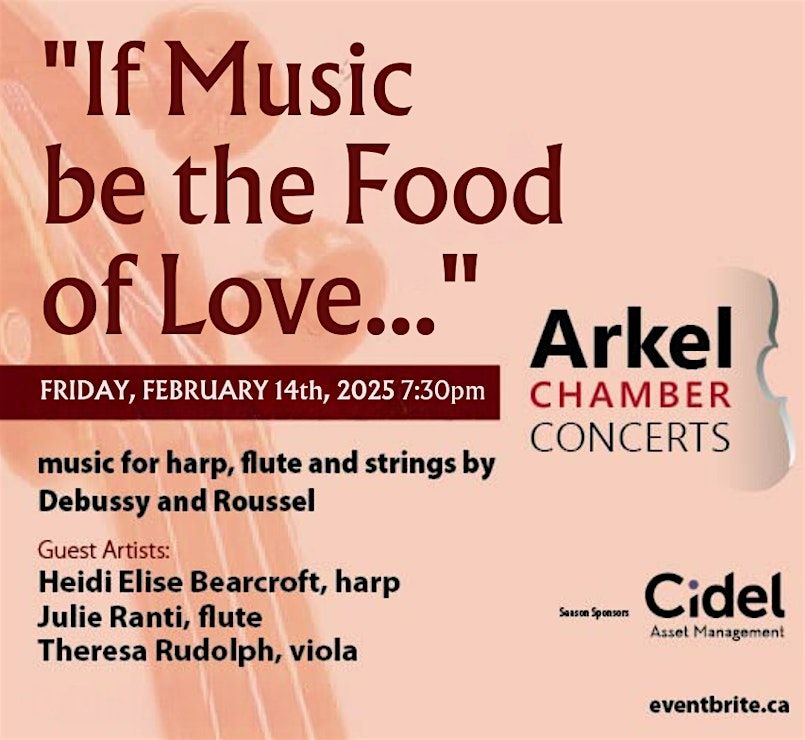"If Music be the Food of Love..."
Schedule
Fri Feb 14 2025 at 07:30 pm to 09:00 pm
UTC-05:00Location
Trinity-St. Paul's United Church and Centre for Faith, Justice and the Arts | Toronto, ON

About this Event

Tickets - $40*
Friday, February 14, 2024 at 7:30 PM
Trinity St. Paul's Centre, Jeanne Lamon Hall
Tickets will be for general seating.
Out of respect for our guests, our performance is a scent-free environment.
Debussy's Sonata for Flute, Viola and Harp
The earliest two works composed for flute, viola, and harp are Théodore Dubois's Terzettino (1905) and Claude Debussy's Sonata for Flute, Viola and Harp (1915). Written ten years after the Terzettino, Debussy's famous sonata for these instruments is a multi-movement work that explores less-traditional tonalities and a wider range of emotions through its ethereal, transparent sound and careful interplay between the instrumental voices. Originally composed for flute, oboe, and harp, Debussy changed the planned instrumentation of his trio to make use of the viola's more flexible timbre that unifies the harp and flute sounds. Debussy's Trio for Flute, Viola and Harp is known a staple for the ensemble and the model that inspired other composers to write for the same instrumentation. Both of these early works for flute, viola and harp demonstrate the ensemble's unique sound, paving the way for numerous trios by various composers in the twentieth and twenty-first centuries.
(Wikipedia)
Debussy's Syrinx
Syrinx is a piece of music for solo flute which Claude Debussy wrote in 1913. It generally takes three minutes or less to perform. It was the first significant piece for solo flute after the Sonata in A minor composed by C.P.E Bach over 150 years before (1747[1]), and it is the first such solo composition for the modern Böhm flute, developed in 1847.[2]
Syrinx is commonly considered to be an indispensable part of any flutist's repertoire. Many musical historians believe that "Syrinx", which gives the performer generous room for interpretation and emotion, played a pivotal role in the development of solo flute music in the early twentieth century. Some say Syrinx was originally written by Debussy without barlines or breath marks.
(Wikipedia)
Roussel's Op. 30 Serenade for Flute, Harp, and String Trio
By the beginning of World War I, Albert Roussel had composed many songs and chamber works, several orchestral pieces, and a very successful ballet. He had been dropped from the naval reserve due to his poor health, but with the outbreak of the war, he joined the Red Cross as an ambulance driver and then the army as an artillery lieutenant. (He was invalided out of the service in January 1918.) After the war and much reflection, Roussel took a new direction in his music, toward a more austere, personal style.
The Op. 30 Serenade for Flute, Harp, and String Trio makes an attractive case for that style. “I have always considered the evolution of style an expansion, a generalization, within ever wider limits, of the sonorous play long familiar to our ears and our musical feeling,” Roussel wrote to Nadia Boulanger the year before he composed the Serenade in 1925. Its outer movements are fleet, rhythmically insistent dances, sprightly and cheerful in the Allegro, manic and extravagantly colorful in the Presto. Between them is a languid, lyrical exploration of all the sonorous possibilities and combinations of these instruments, in which Roussel’s expertise in counterpoint becomes apparent.
(John Henken)
Questions?
Please contact [email protected] .
Not available to enjoy our performance? Please consider a donation in support of our work bringing music to our communities. A tax receipt will be available upon request - please contact [email protected] for more information.
Season 12 is generously sponsored by

Where is it happening?
Trinity-St. Paul's United Church and Centre for Faith, Justice and the Arts, 427 Bloor Street West, Toronto, CanadaEvent Location & Nearby Stays:
CAD 40.00



















